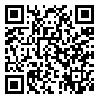BibTeX | RIS | EndNote | Medlars | ProCite | Reference Manager | RefWorks
Send citation to:
URL: http://jdisabilstud.org/article-1-2527-en.html
2- Professor, Department of Psychology, Faculty of Education and Psychology, Shahid Beheshti University, Tehran, Iran
3- Associate Professor, Department of Psychology, Faculty of Education and Psychology, Shahid Beheshti University, Tehran, Iran
Abstract
Background & Objectives: Generalized Anxiety Disorder (GAD) is one of the most frequent and pervasive anxiety disorders characterized by persistent and excessive worrying or anxiety about some events or activities. These people's difficulties in controlling worry cause many personal and social problems that need to be addressed. GAD's Information processing models show how anxious individuals process threatening information as a causal role in developing and preserving worry. Substantial evidence exists in which individuals with GAD and high worry and anxiety levels demonstrate attentional bias to threatening information. Based on the literature, it is possible to rehabilitate attentional biases in these people through potential attention training programs. Training attention may decrease attention biases to threatening information, cause reduced anxiety and worry levels in individuals with GAD, and improve their personal and social functions. Therefore, the present study aimed to evaluate the effectiveness of cognitive rehabilitation of attentional bias to reduce the attentional bias on conscious and unconscious levels in Iraqi adolescents with GAD.
Methods: The present study was a quasi–experimental study with a pretest–posttest design and a three–month follow–up in a group of Iraqi adolescents with GAD. The statistical population was all the Iraqi adolescents between the ages of 15 and 18 living in Najaf City, suffering from GAD. The sample included 17 adolescents (7 girls and 10 boys) with GAD selected from the statistical population using the targeted sampling method. Instruments used to screen anxiety disorders and assess attention biases in the sample were the Screen for Child Anxiety–Related Emotional Disorders (SCARD) (Birmaher et al., 1997) and the Dot–Probe test. The Dot–Probe test was used to evaluate unconscious (stimulus presentation time of 200 ms) and conscious (stimulus presentation time of 500 ms) levels of attention bias for the fearful and neutral facial emotion expressions. After screening participants between 15 and 18 for GAD with the SCARED by a certified psychiatrist, those qualified to attend our study completed the Dot–Probe task before, immediately after, and three months after the intervention. The intervention consisted of 12 one–hour sessions of a cognitive rehabilitation program called ABR, which was created by its creator. To analyze the collected data, repeated measures of variance analysis and post hoc test LSD were done using SPSS software. Time levels (pretest, posttest, and follow–up) were used as within–subject factors in repeated measure analyses. Differences in reaction times to congruent and incongruent stimuli were assessed for conscious and unconscious situations.
Results: The results of repeated measures analysis of variance showed a significant difference in reaction time variables to congruent stimuli and attention bias index in the conscious situation from pretest to follow–up (p<0.001). However, there was no significant difference between the reaction time to the incongruent stimulus from the pretest to the follow–up (p=0.250). Also, in the unconscious situation, between the reaction time to the congruent stimulus (p=0.111) and the attention bias index (p=0.061), no significant difference was observed from the pretest to follow–up. However, the reaction time to the incongruent stimulus from the pretest to follow–up showed a significant difference (p=0.018). The results of the post hoc test LSD showed a significant difference between the pretest and posttest scores (p=0.002) and follow–up (p<0.001) in the reaction time variable to the congruent stimulus in the conscious situation, and according to the average values, the posttest and follow–up scores compared to pretest decreased. However, no significant difference was observed between the posttest and follow–up scores, which indicated the persistence of the intervention effect over time (p=0.490). For the index of attention bias in the conscious situation, the follow–up test results indicated a significant difference between the pretest, posttest, and follow–up scores (p=0.004). In other words, the index of attention bias in the posttest and follow–up compared to the pretest was accompanied by a decrease. However, no significant difference was observed between the posttest and follow–up scores in the attention bias index in the conscious situation, indicating the intervention effect's durability over time (p=0.390). In the unconscious situation, the results showed only a significant difference between the pretest and posttest scores for reaction time to the incongruent stimulus (p=0.021).
Conclusion: Based on the findings, the cognitive rehabilitation intervention of correction of attention bias (ABR) can penetrate and be effective at the unconscious level in addition to correcting the attention bias at the conscious level, and can create changes in the attention bias at two levels in people with GAD.
| Rights and permissions | |
 |
This work is licensed under a Creative Commons Attribution-NonCommercial 4.0 International License. |



